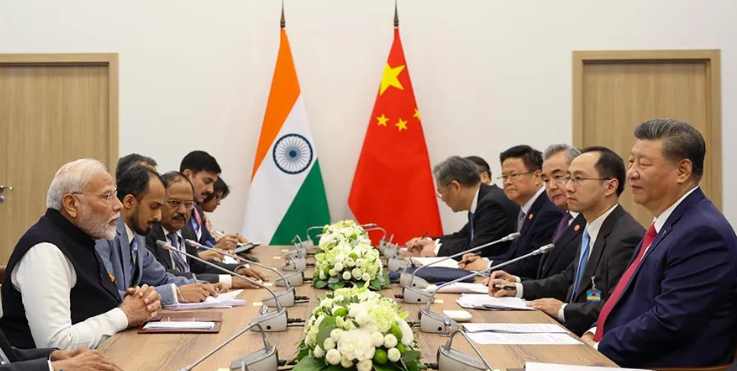16th BRICS Summit and the India-China Border Agreement (GS Paper 2, IR)

Context
- The 16th BRICS Summit took place in Kazan, Russia, marking a significant moment in international relations, especially for India and China.
- This summit was particularly notable as it coincided with a crucial agreement reached between the two nations regarding their contentious border issues, which had escalated dramatically since 2020.
- This meeting was the first substantial bilateral discussion since the tensions erupted, highlighting a potential thaw in their relationship.
Key Developments at the Summit
Membership Expansion
- The summit introduced four new members—Egypt, Ethiopia, Iran, and the UAE—to the BRICS alliance, expanding its reach and influence.
- This inclusion signifies a broader commitment to diversity and representation in global governance, showcasing BRICS as a platform that accommodates emerging economies with varied perspectives.
Focus on Multilateralism
The leaders at the summit emphasized the necessity of multilateralism in addressing global challenges. Key topics included:
- Counter-Terrorism: The need for collective action against terrorism to enhance security.
- Economic Growth: Strategies for promoting sustainable economic development among member states.
- Global South Representation: Addressing the unique concerns and aspirations of nations in the Global South.
Kazan Declaration
The Kazan Declaration emerged as a key document from the summit, encapsulating BRICS's stance on several geopolitical issues:
- Ukraine Conflict: A strong call for dialogue and diplomacy to mediate a peaceful resolution.
- Middle East Crisis: Expressing deep concern over humanitarian crises, particularly in Gaza and Lebanon, and condemning civilian casualties.
- Sanctions: Critiquing the impact of unilateral sanctions on international trade and the global economy, which often hinder development efforts.
Financial Integration and Local Currencies
The summit underscored the importance of financial cooperation among BRICS countries, with a focus on:
- Promoting trade in local currencies to reduce dependency on the US dollar.
- Establishing a BRICS payment system to provide a viable alternative to SWIFT, enhancing cross-border payment mechanisms.
- India’s Unified Payments Interface (UPI) was highlighted as a successful model for efficient digital payments and financial integration.
Wildlife Conservation Initiatives
- Another significant outcome was the support for wildlife conservation, particularly for endangered species like big cats.
- India proposed the establishment of an International Big Cats Alliance, encouraging collaborative efforts among member countries to protect these vulnerable species.
Highlights of the India-China Bilateral Meeting
Following the summit, a pivotal bilateral meeting between India and China took place, focusing on de-escalating tensions stemming from border disputes. The key elements included:
- Border Agreement: A mutual commitment to "complete disengagement" in disputed areas, particularly in the Depsang Plains and Charding Nullah, where both nations agreed to allow troops to patrol traditional Patrolling Points (PPs) along the Line of Actual Control (LAC).
- This agreement represents a significant shift in China’s previous stance, which had been reluctant to discuss these specific areas during earlier negotiations.
Understanding BRICS
Formation and Evolution
- BRICS was originally conceived as BRIC in 2006, comprising Brazil, Russia, India, and China.
- In 2010, South Africa joined, creating the BRICS grouping as we know it today.
- The alliance seeks to promote economic cooperation and enhance political influence for emerging economies in a landscape traditionally dominated by Western powers.
Current Membership
As of 2024, BRICS includes:
- Brazil
- Russia
- India
- China
- South Africa
- Egypt
- Ethiopia
- Iran
- UAE
- Saudi Arabia (pending formalization)
Global Impact
- BRICS nations collectively represent about 40% of the world’s population and account for 26% of global GDP.
- The inclusion of major oil-producing countries like Iran, Saudi Arabia, and the UAE enhances BRICS's strategic importance in global energy markets.
Challenges Faced by BRICS
While BRICS aims to strengthen its position, it faces several significant challenges:
Financial Dominance of the US Dollar
- Despite aspirations to create a multipolar financial system, efforts to diminish the dollar's dominance have made slow progress.
- The New Development Bank (NDB), established to provide an alternative to Western financial institutions, has yet to achieve lending levels comparable to the World Bank.
Geopolitical Diversity and Contradictions
- The diversity within BRICS can complicate consensus-building. Countries like the UAE and Egypt have strong ties with the US, while Iran's adversarial relationship with Western powers poses challenges.
- This geopolitical complexity could hinder cohesive action within the alliance.
Decision-Making Challenges
- As BRICS expands, achieving consensus becomes increasingly complex.
- The group's reliance on unanimous decision-making may lead to difficulties in effectively addressing issues, reminiscent of the Non-Aligned Movement (NAM), which has struggled to exert influence despite its continued existence.
Moving Forward: Strategies for Strengthening BRICS
To enhance the efficacy and influence of BRICS, member countries should consider the following strategies:
Establish Clear Shared Objectives
- Identifying and prioritizing common goals—such as trade cooperation, technological exchange, and security collaboration—will be vital for fostering unity and strategic alignment.
Promote Economic Resilience
- Engaging in initiatives that enhance collaboration in supply chains, energy security, and food systems can strengthen the economic foundations of BRICS member countries.
Foster Dialogue and Respect for Sovereignty
- Encouraging open dialogue among members to respect each nation's security concerns and interests will promote a more cooperative and harmonious environment.
Address Internal Disparities
- Working towards a more equitable representation and involvement of all member countries can mitigate feelings of marginalization and enhance collaboration.
Conclusion
- The 16th BRICS Summit and the associated India-China border agreement signify important developments in both regional and global geopolitics.
- As BRICS continues to evolve and expand, its ability to navigate internal challenges and external pressures will be crucial in shaping its role as a formidable force in international relations.
- The collaborative efforts initiated at this summit may lead to a more unified approach among emerging economies, ultimately altering the dynamics of global governance and economic cooperation.


